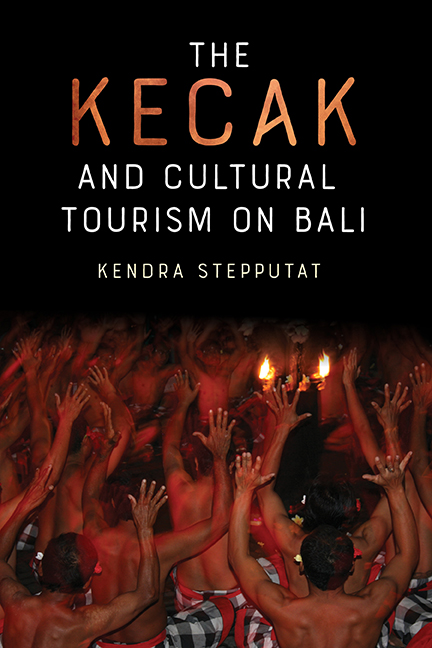Book contents
- Frontmatter
- Contents
- Acknowledgments
- Note to the Reader
- Introduction
- Part 1 The Present
- Part 2 The History
- Appendix 1 Kecak dan Wisata Budaya di Bali (Indonesian Summary)
- Appendix 2 Kecak Groups of Bali in 2000–2001 (Badung and Gianyar)
- Appendix 3 Facsimile of a Letter from Walter Spies to Leo Spies, 1932
- Glossary
- Bibliography
- Index
6 - From Sanghyang Dedari to Kecak
Published online by Cambridge University Press: 07 October 2022
- Frontmatter
- Contents
- Acknowledgments
- Note to the Reader
- Introduction
- Part 1 The Present
- Part 2 The History
- Appendix 1 Kecak dan Wisata Budaya di Bali (Indonesian Summary)
- Appendix 2 Kecak Groups of Bali in 2000–2001 (Badung and Gianyar)
- Appendix 3 Facsimile of a Letter from Walter Spies to Leo Spies, 1932
- Glossary
- Bibliography
- Index
Summary
The tourist performance kecak has a direct predecessor: the trance-possession ritual sanghyang dedari. The settings for the two dance traditions could not be further apart, yet the two genres are closely related in many ways. This is common knowledge among Balinese and has been explicitly recorded by travelers and expatriates in a number of written sources dating back to the 1920s and 1930s. In order to understand how sanghyang and kecak are related yet distinct and how a trance-possession ritual could be turned into a tourist performance art, it is essential to look at sanghyang dedari practice before kecak came into existence. I focus on sources from that time but also include accounts dating back to as early as 1910, thus examining sanghyang dedari as a historical practice. Following the development of sanghyang into a staged ritual up to the point when the kecak separated from the sanghyang, I also share some insights into the parallel development of sanghyang as a community-based ritual practice on the one hand and a staged ritual in performances for tourists on the other.
Ritual Structures
On Bali, there is no stigma attached to a person going into a trance. On the contrary, since trance and possession here “occur in many aspects of daily life,” people who fall into a trance are considered to be within the socially accepted norm. Their going into a trance is “socially approved, facilitated, and controlled.” Suryani and Jensen also state, “Possession to the Balinese is rarely a sinister happening; rather, it is in most instances a pleasurable and valued experience. Furthermore, possession in a religious context is regarded as a privilege to the possessed person.” One such event where trance is channeled into a movement art is the trance-possession dance sanghyang. It is considered to be one of the oldest dance genres on Bali, having cultural roots that probably date to pre-Hindu times. All sanghyang dances include ritual trance-possession elements called karauhan in Balinese, a word based on the verb rauh, whose literal meaning is “arrive” but which is mostly translated as “trance” or “spirit possession.” The spirits coming “down” to possess dancers in sanghyang range from animal spirits, such as in sanghyang jaran (hobby horse dance), to divine beings, such as in sanghyang dedari.
- Type
- Chapter
- Information
- The Kecak and Cultural Tourism on Bali , pp. 195 - 236Publisher: Boydell & BrewerPrint publication year: 2021

